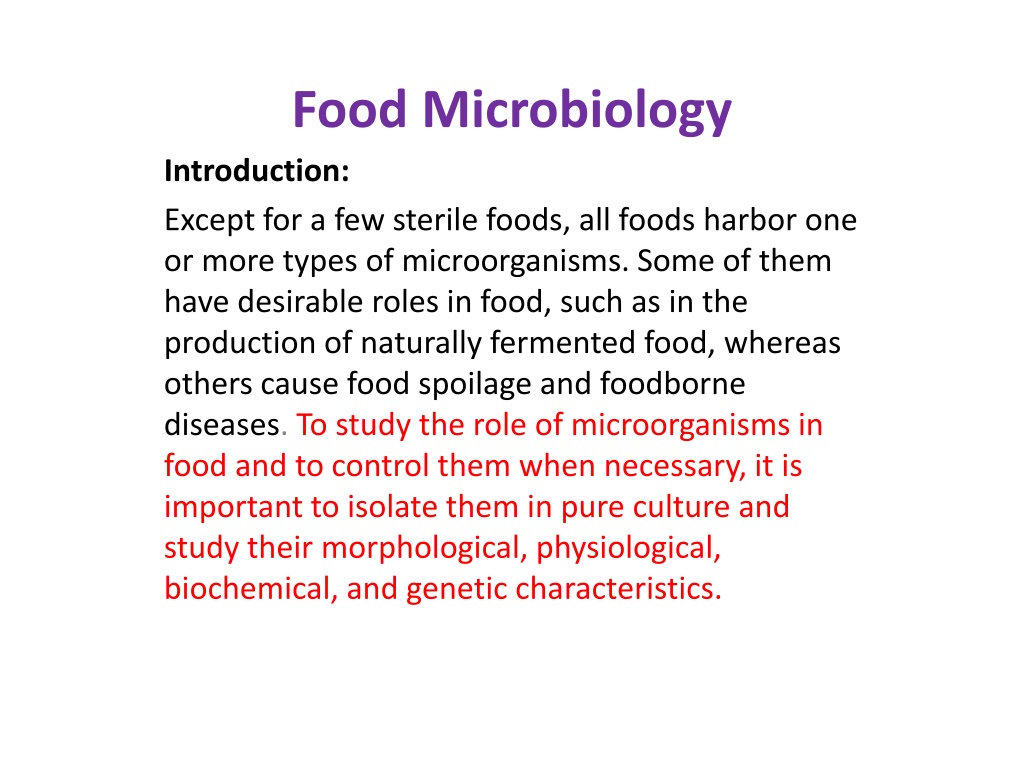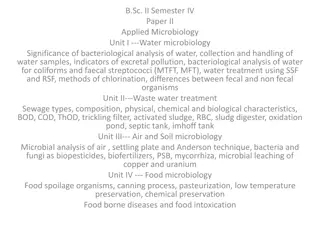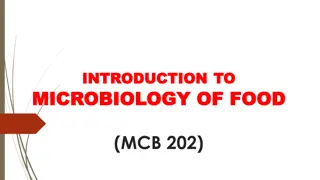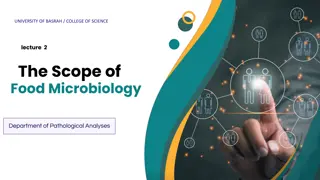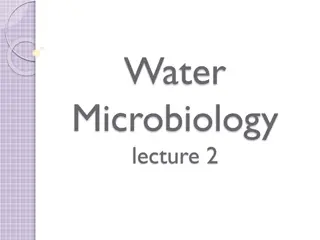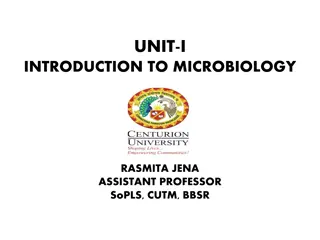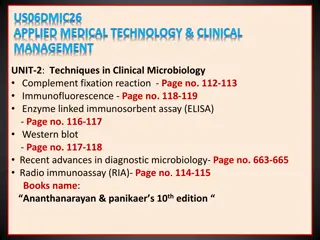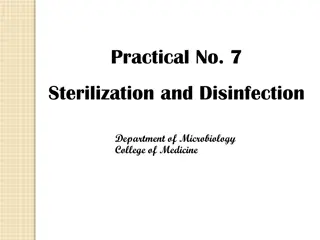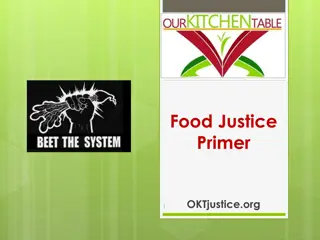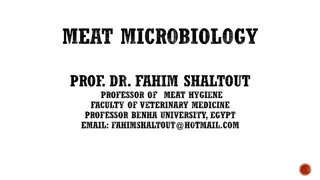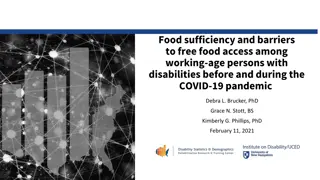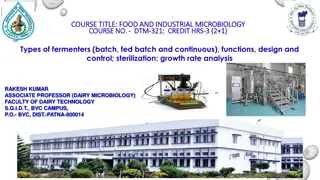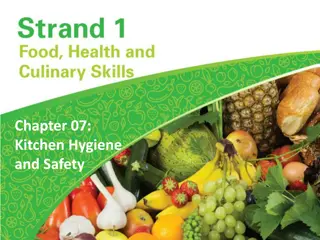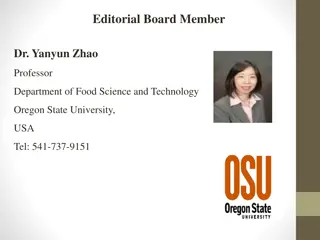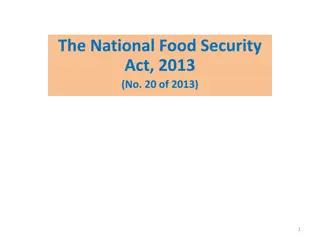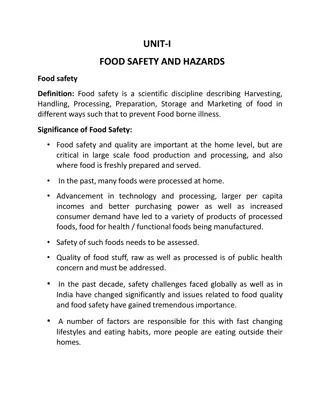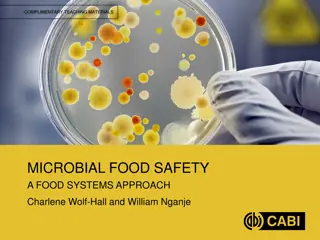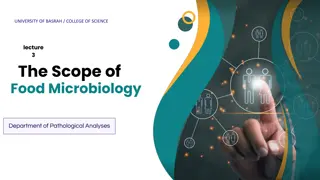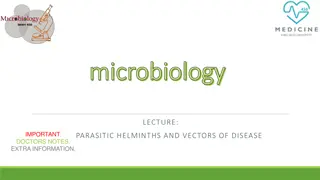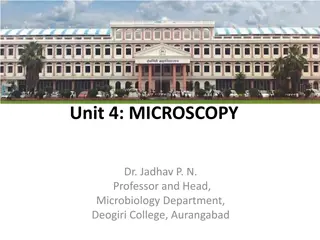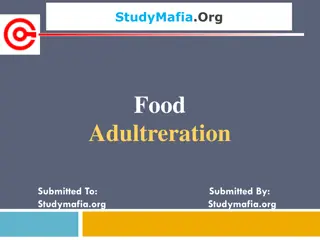Exploring the World of Food Microbiology
The field of food microbiology delves into the intricate relationship between microorganisms and food, covering aspects such as fermentation, spoilage, and probiotics. Discoveries by pioneers like Pasteur paved the way for understanding the roles of microorganisms in food production and preservation. Ongoing research focuses on genetic manipulation of strains, biopreservation, and combating food spoilage through innovative methods.
Download Presentation

Please find below an Image/Link to download the presentation.
The content on the website is provided AS IS for your information and personal use only. It may not be sold, licensed, or shared on other websites without obtaining consent from the author. Download presentation by click this link. If you encounter any issues during the download, it is possible that the publisher has removed the file from their server.
E N D
Presentation Transcript
Food Microbiology Introduction: Except for a few sterile foods, all foods harbor one or more types of microorganisms. Some of them have desirable roles in food, such as in the production of naturally fermented food, whereas others cause food spoilage and foodborne diseases. To study the role of microorganisms in food and to control them when necessary, it is important to isolate them in pure culture and study their morphological, physiological, biochemical, and genetic characteristics.
The first person to appreciate and understand the presence and role of microorganisms in food was Pasteur. In 1837, he showed that the souring of milk was caused by microorganisms, and in about 1860 he used heat for the first time to destroy undesirable organisms in wine and beer. This process is now known as pasteurization.
Availability of basic information on the physiological, biochemical, and biological characteristics of diverse types of food, microbial interactions in food environments and microbial physiology, biochemistry, genetics, and immunology has helped open new frontiers in food microbiology. Among these are:
A. Food Fermentation/Probiotics Development of strains with desirable metabolic activities by genetic transfer among strains Development of bacteriophage-resistant lactic acid bacteria Metabolic engineering of strains for over production of desirable metabolites Development of methods to use lactic acid bacteria to deliver immunity proteins Sequencing genomes of important lactic acid bacteria and bacteriophages for better understanding of their characteristics Food biopreservation with desirable bacteria and their antimicrobial metabolites Understanding of important characteristics of probiotic bacteria and development of desirable strains Effective methods to produce starter cultures for direct use in food processing
B. Food Spoilage Identification and control of new spoilage bacteria Spoilage due to bacterial enzymes of frozen and refrigerated foods with extended shelf life Development of molecular methods (nanotechnology) to identify metabolites of spoilage bacteria Importance of environmental stress on the resistance of spoilage bacteria to antimicrobial preservatives
C. Foodborne Diseases Methods to detect food borne pathogenic bacteria from contaminated foods Application of molecular biology techniques (nanotechnology) for rapid detection of pathogenic bacteria in food and environment Effective detection and control methods of food borne pathogenic viruses Transmission potentials of prion diseases from food animals to humans Importance of environmental stress on the detection and destruction of pathogens Factors associated with the increase in antibiotic-resistant pathogens in food Adherence of food borne pathogens on food and equipment surfaces Mechanisms of pathogenicity of food borne pathogens Effective methods for epidemiology study of food borne diseases Control of pathogenic parasites in food.
Contamination of Foods: The internal tissues of healthy plants (fruits and vegetables) and animals (meat) are essentially sterile. Yet raw and processed (except sterile) foods contain different types of molds, yeasts, bacteria, and viruses. Microorganisms get into foods from both natural (including internal) sources and from external sources to which a food comes into contact from the time of production until the time of consumption.
Sources of contamination: A. Plants (Fruits and Vegetables) Fruits and vegetables harbor microorganisms on the surface; their type and level vary with soil condition, type of fertilizers andwater used, and air quality. Molds, yeasts, lactic acid bacteria, and bacteria from genera Pseudomonas, Alcaligenes, Micrococcus, Erwinia, Bacillus, Clostridium, and Enterobacter can be expected from this source
Diseases of the plants, damage of the surface (before, during, and after harvest), long delay between harvesting and washing, and unfavorable storage and transport conditions after harvesting and before processing can greatly increase microbial numbers as well as predominant types. Improper storage conditions following processing can also increase their numbers.
B. Animals, Birds, Fish, and Shellfish Food animals and birds normally carry many types of indigenous microorganisms in the digestive, respiratory, and urinogenital tracts, the teat canal in the udder, as well as in the skin, hooves, hair, and feathers. Many, as carriers, can harbor pathogens such as Salmonella serovars, pathogenic Escherichia coli, Campylobacter jejuni, Yersinia enterocolitica, and Listeria monocytogeneswithout showing symptoms. Laying birds have been carrying Salmonella Enteritidis in the ovaries and contaminating the yolk during ovulation.
Fish and shellfish also carry normal microflora in the scales, skin, and digestive tracts. Water quality, feeding habits, and diseases can change the normal microbial types and level. Pathogens such as Vibrio parahaemolyticus,and V.choleraeare of major concern from these sources. In addition to enteric pathogens from fecal materials, meat from food animals and birds can be contaminated with several spoilage and pathogenic microorganisms from skin, hair, and feathers, namely Staphylococcus aureus, Micrococcus spp., Propionibacteriumspp., Corynebacteriumspp., and molds and yeasts.
C. Air Generally, dry air with low dust content and higher temperature has a low microbial level.Spores of Bacillus spp., Clostridium spp., and molds, and cells of some Gram positive bacteria (e.g., Micrococcus spp. and Sarcinaspp.), as well as yeasts, can be predominantly present in air.
Microbial contamination of food from the air can be reduced by removing the potential sources, controlling dust particles in the air (using filtered air), using positive air pressure, reducing humidity level, and installing UV light.
D. Soil Soil contains several varieties of microorganisms. Because microorganisms can multiply in soil, their numbers can be very high (billions/g). Many types of molds, yeasts, and bacterial genera (e.g., Enterobacter, Pseudomonas, Proteus, Micrococcus, Enterococcus, Bacillus, and Clostridium) can enter foods from the soil. Soil contaminated with fecal materials can be the source of enteric pathogenic bacteria and viruses in food.
E. Sewage To reduce incidence of microbial contamination of foods from sewage, it is better not to use sewage as fertilizer. If used, it should be efficiently treated to kill the pathogens. Also, effective washing of foods following harvesting is important
F. Water Contamination of foods with pathogenic bacteria, viruses, and parasites from water has been recorded. Potable water does not contain coliforms and pathogens (mainly enteric types), it can contain other bacteria capable of causing food spoilage, such as Pseudomonas, Alcaligenes, and Flavobacterium.
G. Humans Between production and consumption, foods come in contact with different people handling the foods. Human carriers have been the source of pathogenic microorganisms in foods that later caused food borne diseases, especially with ready to eat foods. Improperly cleaned hands, lack of aesthetic sense and personal hygiene,and dirty clothes and hair can be major sources of microbial contamination in foods.
In addition to spoilage bacteria, pathogens such as Staphylococcus.aureus, Salmonella serovars, Shigellaspp., pathogenic E. coli, and hepatitis A can be introduced into foods from human sources.
H. Food Ingredients In prepared foods, many ingredients or additives are included indifferent quantities. Many of these ingredients can be the source of both spoilage and pathogenic microorganisms. Various spices generally have very high populations of mold and bacterial spores. Starch, sugar, and flour might have spores of thermophilic bacteria.
I. Equipment A wide variety of equipment is used in harvesting, slaughtering, transporting, processing,and storing foods. Many types of microorganisms from air, raw foods, water,and personnel can get into the equipment and contaminate foods.
Salmonella, Listeria, Escherichia, Enterococcus,Micrococcus, Pseudomonas, Lactobacillus, Leuconostoc, Clostridium, Bacillus spp.,and yeasts and molds can get in food from equipment . Cleaning and sanitation of equipment are important to reduce microbial levels in food. J. Miscellaneous Foods might be contaminated with microorganisms from several other sources, namely packaging and wrapping materials, containers, flies, vermin, birds, house pets, and rodents.
